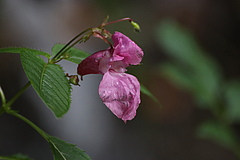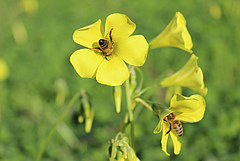Dimensions of invasion success

Himalayan balsam (Impatiens glandulifera) (Picture: Trevor Fristoe)

African wood-sorrel (Oxalis pes-caprae) (Picture: Mark van Kleunen)
Patterns and drivers of alien plant species invasiveness in Europe identified by an international research team
Based on a media release of the University of Konstanz
Invasive alien plants are plant species that grow in an environment outside their native habitat. If they successfully establish self-sustaining populations in these new environments – an event called “naturalization” – they can have considerable negative impacts on local ecosystems, economies, and societies. But not all alien plant species are equally effective in invading new habitats. Therefore, an international team of scientists, including several iDiv members and headed by Konstanz-based biologist Professor Mark van Kleunen, investigated different types of “invasiveness” and possible factors that determine invasion success of alien plants in Europe.
The new study, published in PNAS, describes plant species invasiveness using three distinct dimensions: local abundance, geographic extent, and habitat breadth. In the current study, these dimensions were assessed at a continental scale for large proportions of the alien and native European floras. High values in the variables characterise the most successful invaders. Introduction histories play an important role in performance along the three dimensions, as do some biological traits: Early introduction to Europe, non-European origin, and rapid growth are characteristics common to many “super-invaders”. The findings of the study improve our general understanding of how plant species – invasive and native ones – distribute and may help to better predict and manage future plant invasions.
Key facts
- Plant species invasiveness is described using three distinct dimensions: local abundance, geographic extent, and habitat breadth. “Super-invaders” are characterised by high values in all three variables.
- Introduction date and geographic origin of an alien invasive plant play important roles in performance along the three dimensions, as do some biological traits that allow for rapid growth.
- The three-dimensional framework of “invasiveness” improves our general understanding of plant distribution dynamics and may help anticipating and managing future invasion events.
View full article of the University of Konstanz here.
Original publication
(Scientists with iDiv affiliation in bold)
Trevor S. Fristoe, ..., Jürgen Dengler, ..., Ute Jandt, ..., Mark van Kleunen. (2021). Dimensions of invasiveness: links between local abundance, geographic range size and habitat breadth in Europe’s alien and native floras, PNAS; DOI: 10.1073/pnas.2021173118
